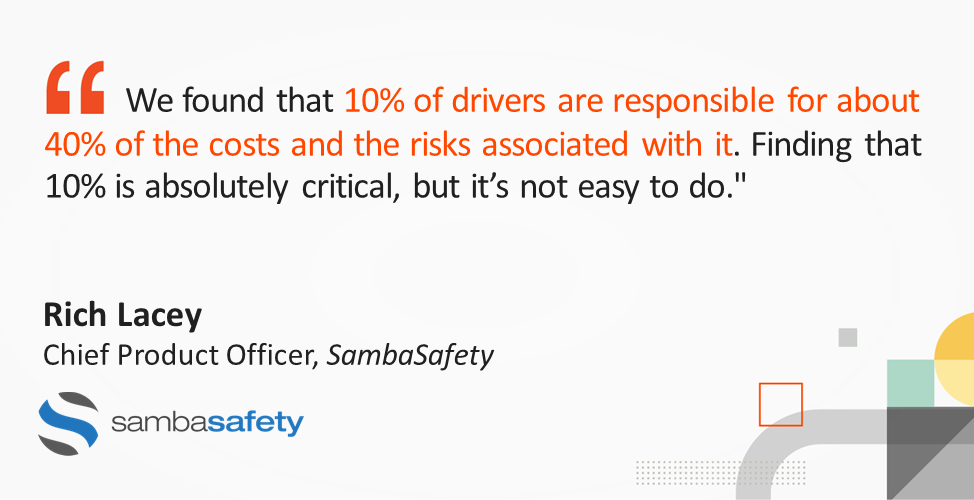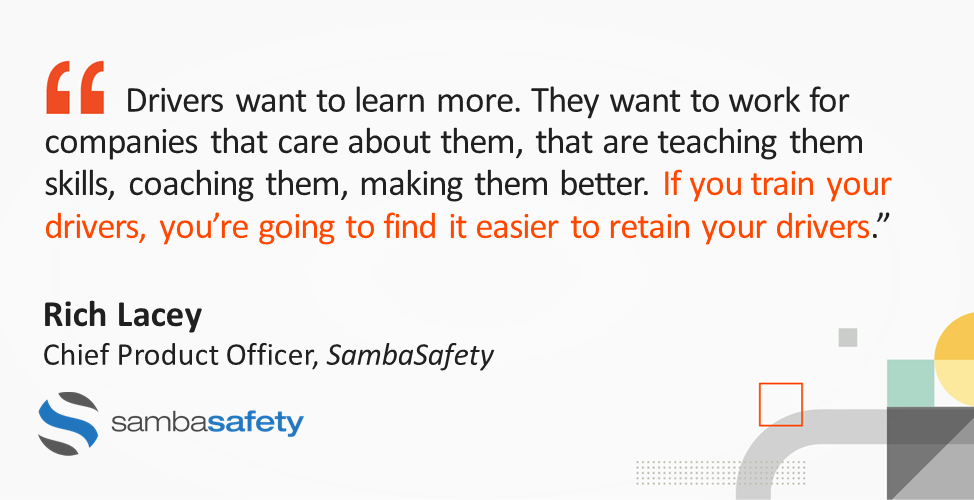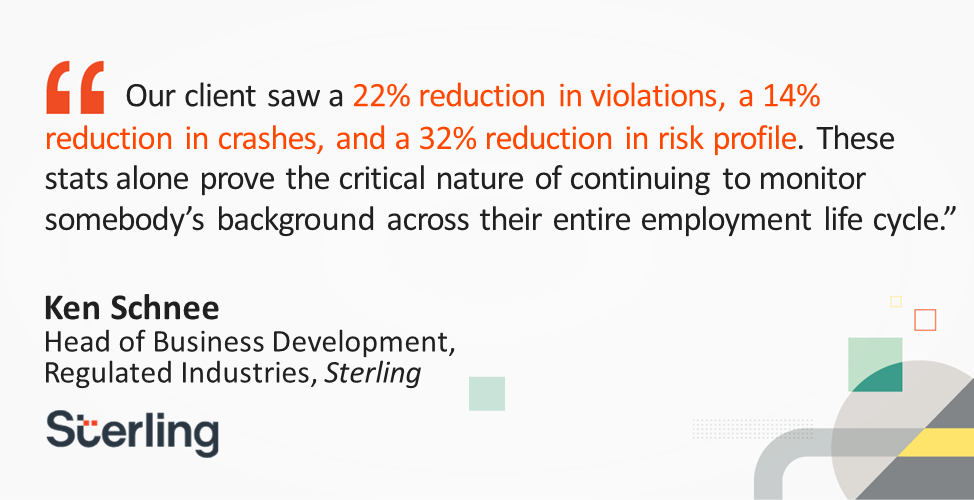October 26th, 2023 | Sterling
Keep Your Drivers on the Road with Continuous MVR and License Monitoring

For over 20 years, Sterling and SambaSafety have partnered together to help organizations manage their drivers by increasing visibility, improving compliance, and automating the pre- and post-hire screening process. Our longstanding partnership has enabled us to develop innovative and unique driver solutions that have helped organizations proactively manage risk and reduce liability.
Sterling and SambaSafety recently came together for a live discussion to talk about the importance of using continuous MVR and license monitoring.
Katelyn Brower, Social Media Manager at Sterling, was joined by Ken Schnee, Head of Business Development of Regulated Industries at Sterling, and Rich Lacey, Chief Product Officer at SambaSafety. In the live video, they shared the challenges posed by manual monitoring of driver behavior, the business importance of developing a seamless driver monitoring process from pre-hire to post-hire, and how MVR and license monitoring has helped organizations make more efficient decisions in how they manage their fleet.
Drivers Hail From All Over, but Their Challenges Are the Same
When we think about drivers and driver management, the most common example of drivers is in the trucking industry. Today’s drivers come to work from many different demographics and backgrounds. Rich shared more on this: “Not only is there the trucking industry, but there are the medium and light duty trucks. There are your service vehicles that are corporate-owned, have a logo on the side, but they’re driving through neighborhoods. There are people that drive their own cars for work. Think of salespeople and home healthcare workers; they’re getting mileage, reimbursements, or car allowances. And then there’s the gig economy, and ride share, which is pervasive.”
Even though the risk may be subtly different across all these drivers, the challenges they face are surprisingly similar. Most of these organizations have a well-thought-out safety policy, but enforcing that policy is all too often done through a manual process, leaving plenty of opportunities for human error. Rich outlined this challenge: “Enforcing a driver safety policy across the board is really difficult without some form of automation. When we surveyed our customer base, we found that it’s 10% of drivers that are responsible for about 40% of the costs and the risks associated with it. Finding that 10% is absolutely critical, but it’s not easy to do.”

Tracking Driver Behavior with Automation Reduces Turnover and Improves Retention
Driver shortages are top of mind for many organizations. That’s why developing an effective talent acquisition strategy has been a priority to fill this gap. But hiring managers are also focused on reducing their turnover rates and improving their driver retention. How does a continuous MVR and license monitoring solution help with that?
“Ultimately turnover is what’s going to cause a reduction in your force, whether it’s warranted or not warranted,” said Ken. “In partnering with SambaSafety, we saw a 27% reduction in citations across the average driver base from our clients. Not only will you see less citations from using a monitoring tool, but you’ll also have early visibility into citations, or even speeding tickets or seat belt citations, and you can take action on those things in real time so you can prevent your organization from hitting that turnover curve.”
Hiring managers often think about the risk and safety implications involved with reckless driver behavior, but there’s also an important compliance piece employers need to consider: “Lots of times you’ll find a driver who has an invalid license and it has nothing to do with how they drive,” continued Rich. “It’s an administrative suspension, or maybe they didn’t pay a parking ticket, or they didn’t pay child support, it just depends on the state. With continuous monitoring, employers can proactively work with their drivers and rectify these issues. These are easily preventable if you know ahead of time that your driver has an invalid license that’s not related to how they drive.”
It’s clear that incorporating a continuous MVR and license monitoring tool can greatly impact turnover rates, but more importantly it can be a powerful retention tool: “You can increase retention by investing in driver safety,” said Rich. “Drivers want to learn more. They want to work for companies that care about them, that are teaching them skills, coaching them, making them better. If you train your drivers, you’re going to find it easier to retain your drivers.”

Sterling and SambaSafety Are Helping Companies in Their Safety Journey
Over the last five years, Sterling and SambaSafety have been focused on the post-hire monitoring aspect of their relationship. Ken shared how the partnership has been able to implement a seamless driver management program that delivers an end-to-end experience for drivers: “You can manage your driver population through a roster, and we’ve developed a way for all of your post-hire screening, whether it’s monitoring or criminal monitoring, I mean, we even integrate with DQF solutions for your driver population, all of this occurs through a single roster for the client. This means the client’s obligation is really just to tell us who’s there, and the rest is taken care of by Sterling.”
Rich continued to reveal SambaSafety’s involvement in the process: “At SambaSafety, we start off by identifying qualified drivers, and our partnership with Sterling is a great example of that. We can take the pre-hire background check that you ran on the Sterling platform and bring that into our monitoring platform, and it becomes the baseline for monitoring. It creates a risk profile and at that point, we’re continuously looking for new violations, changes in license status, and alerting the customer when those changes happen.”
Looking at driver history or MVR changes is important and can be highly predictive of future driver behavior, but there are other data sources that are important to bring in as a part of monitoring: “CSA roadside inspections conducted by the Federal Motor Carrier Safety Administration (FMCSA) and telematics data are two examples,” said Rich. “We also bring in observations that the company has themselves, such as conversations they are having with their drivers, coaching opportunities, including behind the wheel training, maybe even one of those ‘1-800 How’s My Driving?’ bumper sticker programs. Bringing that all together into a single view of risk enables our customers to make smarter decisions.”
What kind of results have we seen from implementing a driver monitoring program? Ken highlighted a success story from one of our clients, a large equipment rental organization: “They saw a 22% reduction in violations, a 14% reduction in crashes, and a 32% reduction in risk profile. Think about the gravity of just those three stats. We’re not only talking about safety for your organization, but we’re talking about the safety of your drivers and everyone around them. These stats alone prove the critical nature of continuing to monitor somebody’s background across their entire employment life cycle.”

Ken goes on to mention how this client also saw associated cost-savings: “They saw a 9% reduction in claims against the organization and $50,000 in annual savings and administrative costs. Looking at the flat cost without even trying to calculate the savings from the reduction in violations, just at the baseline, this pays for itself.”
Final Thoughts
Rich summed up our discussion by concluding: “I think everybody that’s attending this session wants safer roads for their families and they want safer roads for their employees to get home. We all share a common goal. And now we have the tools and technology to help us do that.”
To learn more about our continuous MVR and license monitoring, click here.
Check out this free MVR Monitoring 101 Guide by SambaSafety.
This content is offered for informational purposes only. First Advantage is not a law firm, and this content does not, and is not intended to, constitute legal advice. Information in this may not constitute the most up-to-date legal or other information.
Readers of this content should contact their attorney or lawyer to obtain advice concerning any particular legal matter. No reader, or user of this content, should act or refrain from acting on the basis of information in this content without first seeking legal advice from counsel or lawyers in the relevant jurisdiction. Only your individual attorney or legal advisor can provide assurances that the information contained herein – and your interpretation of it – is applicable or appropriate to your particular situation. Use of, and access to, this content does not create an attorney-client relationship between the reader, or user of this presentation and First Advantage.

